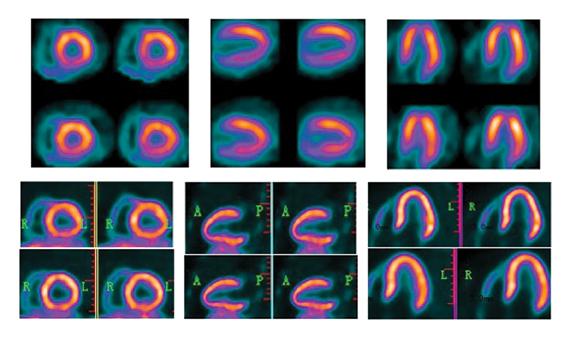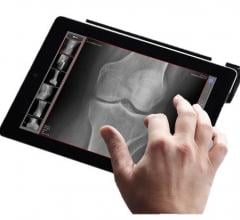
Cleaning your mouth and cleaning your arteries could be as simple as a once-a-day oral rinse if additional clinical studies confirm preliminary findings about a new product. The Biomedical Development Corp. (BDC) presented data in April to the American Academy of Oral Medicine showing that its oral rinse was safe and effective at fighting gingivitis in a recent clinical trial. But the most surprising finding of the study was that users of the oral rinse showed significantly lower LDL cholesterol levels than the placebo group.

Radiation exposure from multidetector computed tomography (CT) has become a pressing public health concern in both lay and medical publications. Implementation of iterative reconstruction offers the ability to minimize radiation exposure while preserving and, in some cases, improving image quality. However, in order to evaluate iterative reconstruction software, one must first understand the basics of how it works.

Just when positron emission tomography (PET) appears to be eclipsing single photon emission computed tomography (SPECT) for cardiac imaging, new advances make SPECT more attractive. Both modalities also have suffered setbacks with radiopharmaceutical supply problems in recent years and both modalities have their pros and cons. Looking toward the future, the question of which modality will dominate remains unanswered. PET shows major promise with exciting new tracers, while new SPECT scanner technology introduced at the Society of of Nuclear Medicine and Molecular Imaging (SNMMI) 2013 meeting may herald a rebirth for SPECT with previously unseen image quality enhancements.
Providing exceptional cardiovascular care for patients to achieve the best possible outcomes is the number one goal for ...

Percutaneous transluminal coronary angioplasty (PTCA) balloon catheters were the first devices used in the field of interventional cardiology. The growth of the stent market, which is the largest segment for interventional cardiology devices, has helped to fuel the sales of PTCA balloons. In addition, this market is driven by U.S. Food and Drug Administration (FDA) policy, pre-/post-stent dilations and plaque debulking.

Computerized and semi-automated inventory control system technology offers a more efficient way for cardiovascular departments, especially catheterization and electrophysiology (EP) labs, to track what is on their shelves, when to re-order supplies, their actual costs per procedure and to identify new ways to cut costs.

Healthcare reform requiring wider access and enterprise sharing of patient images and records are making Web-based cardiology picture archiving and communication systems (PACS) a more attractive solution over traditional thick-client, server-based systems. In just the past few years there has been a departure from thick-client cardiology and radiology PACS to Web-based platforms. There are several reasons for this, including better interoperability, anywhere-anytime access, remote access to data and images, and reduction of IT burdens. Web-based systems also enable easier delivery of many healthcare reform Stage 2 meaningful use (MU) requirements.
Cardiac positron emission tomography (PET) is growing in popularity among cardiologists because it provides the ability ...
Finding ways to lower patient radiation dose from both medical imaging and interventional cardiology has become a major trend. However, when vendors start talking dose, it is important to realize there are no set industry standards agreed upon by manufacturers to calculate dose. For this reason, I call into question vendors’ statistics of how much their technology can lower dose by up to 20, 50 or even 80 percent. While new technologies such as iterative reconstruction, more sensitive detectors and ECG gating do indeed lower dose, quantifying it can be a moving target.

AngioScore Inc. announced the completion of enrollment in the Drug-Coated AngioSculpt Scoring Balloon Catheter First-in-Human (FIH) Study (PATENT-C). AngioScore anticipates that preliminary data from this study will be available for presentation at the Transcatheter Cardiovascular Therapeutics (TCT) conference to be held this fall in San Francisco
Toshiba America Medical Systems Inc. has partnered with Unfors RaySafe Inc. to offer a new radiation dose monitoring and management tool for Infinix-i cardiovascular X-ray systems. The Unfors RaySafe i2 displays real-time dose exposure information, helping to make exams safer for all clinical staff.
When performing radiofrequency (RF) ablation to treat cardiac arrhythmia, medical professionals must balance the safety ...
July 22, 2013 — A new report issued by the American College of Cardiology (ACC) and developed in collaboration with 10 other professional societies provides detailed criteria to help clinicians optimize the appropriate use of certain noninvasive vascular tests when caring for patients with known or suspected disorders of the venous system.
T2 Biosystems announced the presentation of data strongly correlating T2Hemostat results with patients’ clinical outcomes. In 26 patients who presented with chest pain and underwent cardiac catheterization, T2HemoStat was compared to a common platelet activity assay, where T2HemoStat accurately correlated to 100 percent of bleeding event cases while the comparator did not identify bleeding events in any patients. T2HemoStat also correlated to twice the number of thrombotic cases than the comparator. These data are complemented by additional presentations that demonstrate T2MR’s ability to identify novel clot biology, which may account for previously unexplained clot behavior while providing new clinical insights into the formation and degradation of blood clots. T2HemoStat is the company’s novel system for the rapid detection of physical changes in a blood sample, identifying novel clot biology while also measuring hemostasis characteristics such as coagulation, fibrinolysis and platelet function from finger stick size, small volumes of whole blood or plasma on a single, compact instrument.

July 19, 2013 — The Mount Sinai Medical Center is the first medical center in New York City to offer the HeartMate II pocket controller, newly approved by the U.S. Food and Drug Administration (FDA). This latest-generation controller for the HeartMate II left ventricular assist device (LVAD) is a new small, lightweight, patient-friendly external controller about the size of a smart phone.
Change Healthcare Cardiology Hemodynamics is an integrated hemodynamic monitoring system for monitoring vital signs and ...
Itamar-Medical announced that the American Medical Association (AMA) has awarded a Current Procedure Terminology (CPT) Category III reimbursement code to a test performed by its EndoPAT proprietary device.
Abbott announced that it has entered into an agreement to purchase IDEV Technologies, a privately held company focused on developing next-generation medical devices for use by interventional radiologists, vascular surgeons and cardiologists. Under the terms of the agreement, Abbott will acquire all outstanding equity of IDEV Technologies for $310 million net of cash and debt.
July 18, 2013 — Two reports from AmericanEHR Partners, based on a survey of nearly 1,400 physicians, suggest that tablets are of greater use for clinical purposes than smart phones.

 July 23, 2013
July 23, 2013







